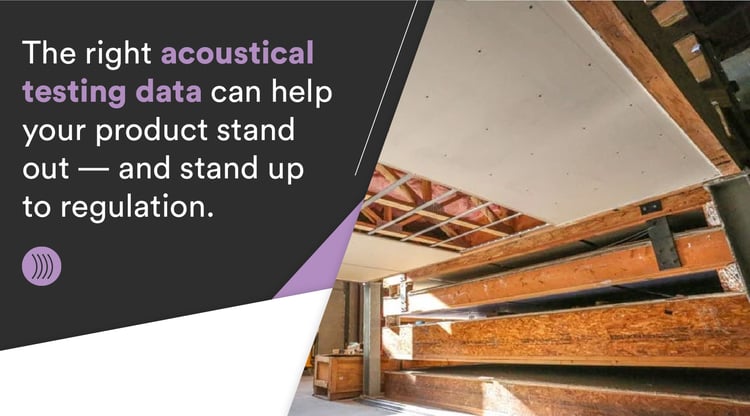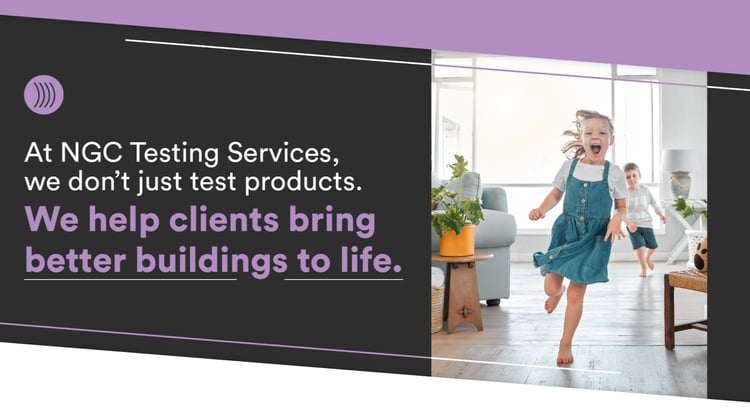Acoustical Testing
Test Standard Spotlight: ISO 10140-2 — Understanding Sound Insulation Testing for Building Products
Imagine moving into a high-end apartment with sleek finishes, floor-to-ceiling windows, and a premium price tag, only to discover that you can hear every word of your neighbor’s late-night TV show.
Or picture settling into your desk at a modern, open-concept office, only to be distracted by nearby meetings, phone calls, and hallway chatter throughout your workday.
From open-concept offices to luxury multifamily housing, today's buildings demand so much more than just structural integrity — they also require acoustic comfort.
Knowing how walls, floors, and ceilings block or carry sound isn’t just about meeting code and certification standards, but also about making sure people are happy living and working in the space.
That’s where ISO 10140-2 testing comes in.
At NGC Testing Services, we help architects, engineers, and manufacturers ensure the products they use meet sound insulation requirements for commercial buildings and beyond.
This article will take you through what ISO 10140-2 entails, pinpoint exactly why it’s important, and highlight how our accredited lab can support your specific acoustic testing needs.
What Is ISO 10140-2?
ISO 10140-2: Acoustics — Laboratory Measurement of Sound Insulation of Building Elements is an internationally recognized standard for evaluating airborne sound insulation.
In simple terms, ISO 10140-2 measures how well a building product prevents sound from passing through it. This standard applies to common building elements such as walls, floors, doors, windows, and façade elements.
ISO 10140-2’s primary goal is to quantify how much sound is blocked when it travels from one side of a building element to the other. This allows manufacturers and specifiers to assess product performance and compare solutions to find the right one for their specific project.
Why ISO 10140-2 Matters in Building Product Development
As cities grow larger and louder, and as building codes evolve, sound insulation in buildings has become a top concern in both residential and commercial development.
Whether you’re working on a hospital, hotel, or high-rise, ISO 10140-2 test results provide a variety of useful information during the design process, including:
- Code compliance with both local and international sound insulation building regulations
- Alignment with sound insulation requirements for commercial buildings and multifamily developments
- Support for green building certification submissions, such as LEED, WELL, etc.
- Proven credibility for marketing claims around sound insulation materials used in buildings and a benchmark for innovation in acoustically advanced product design

The ISO 10140-2 Testing Process at NGC Testing Services
At NGC Testing Services, we’ve streamlined the ISO 10140-2 process to make testing simple, accurate, and efficient. When you work with our team of experts, this is what you can expect:
1. Product Preparation and Submittal
First things first, you’ll send us your product specimen — whether it’s a door, window, wall panel, or floor system — built to a specified size, ready for testing.
2. Laboratory Setup
Next, our team of experts will work to get your product installed in a test laboratory in our Buffalo, NY, facility. These rooms are acoustically isolated and designed for high-precision testing.
3. Sound Source and Receiver Configuration
The testing process involves creating a sound field in a source room and measuring the sound levels in both the source and an adjoining receiving room, separated by the building element being tested.
4. Data Collection and Analysis
Microphones in the receiving room measure how much sound passes through the specimen. Then, using standardized methods, we analyze the difference in sound levels and determine the airborne sound insulation performance of the product.
All testing is performed by experienced professionals using calibrated, high-precision instrumentation and is always conducted in accordance with ISO procedures.
Understanding the Results: STC and Beyond
Once testing is complete, results are expressed in terms of either Sound Transmission Class (STC) in North America and Weighted Sound Reduction Index (Rw) in Europe.
These single-number ratings help designers and manufacturers quickly assess the effectiveness of methods of sound insulation in buildings. Higher numbers mean better sound insulation.
Clients often use these test results in:
- Product labels and technical datasheets
- Marketing collateral
- Architectural specification documents
- Bids and submittals for code and certification review
Clients can leverage ISO 10140-2 test data in a variety of ways — from supporting performance claims on product labels and marketing materials to providing third-party verification in technical datasheets, submittals, and specification documents for vendors, architects, and regulatory bodies.
Frequently Asked Questions
Who should consider ISO 10140-2 testing?
Manufacturers of windows, doors, wall assemblies, and façade elements, architects, as well as developers of commercial or multi-unit residential projects, should utilize ISO 10140-2 testing to optimize sound insulation and noise reduction in their various projects.
How does ISO 10140-2 compare to ASTM E90?
While both standards evaluate airborne sound insulation, ISO 10140-2 is internationally recognized, while ASTM E90 is more common in the United States specifically. Still, NGC Testing Services can test to both standards depending on your market needs.
What is the typical test duration?
It varies. Simple, small elements or products may have a quicker testing turnaround time compared to complex situations such as multi-layered floors or façades. The number of elements being tested will also affect the overall duration of the testing.
Can modifications improve STC results?
Yes. Changes to mass, construction, and sealing techniques can impact sound performance. We offer pre-testing consultations to explore these options, if that’s something you’re considering.
How NGC Testing Services Supports Clients Through ISO 10140-2 Testing
Our goal is to make sound insulation testing for building regulations straightforward and accessible.
Accredited Expertise
As an ISO-accredited facility, all ISO 10140-2 testing is performed in-house by experienced experts familiar with a wide range of standards, including ISO and ASTM. We prioritize efficient scheduling and provide cost-effective testing solutions tailored to your needs.
Collaboration & Combination Testing
Our team will work closely with you before, during, and after the testing process to make sure your project is completed with minimal interruptions. We offer a variety of testing services, including acoustical, fire, structural, and analytical testing, all in one convenient location, so you can streamline your testing process.
Dedicated Guidance Before, During, and After
Need help interpreting your results? Our team provides clear reporting and guidance on what comes next — whether that’s redesigning a product or submitting documentation for code approval.
Let’s Work Together
Ready to validate the acoustic performance of your building product? NGC Testing Services is here to help. Whether you're aiming to meet specific sound insulation building regulations, optimize your product for a LEED submission, or enhance market credibility, our team is your go-to partner.
Contact us today to learn more about ISO 10140-2 testing or our other services.
Search blog articles
Browse by topic
Subscribe for updates
GET IN TOUCH
Contact Us
NGC Testing Services features one of North America's most comprehensive and unique fully accredited testing facilities. Contact us today to visit our 50,000-plus-square-foot facility located in Buffalo, New York.
